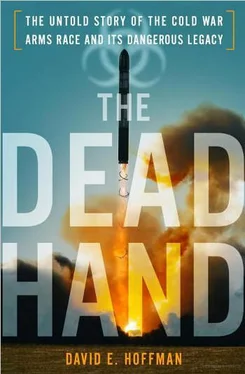When he returned to Koltsovo, laborious and time-consuming synthesis of DNA got underway. The fragments of genetic material had to be fabricated from nucleotides, the fundamental units of nucleic acids, one by one. For a small gene, this might be feasible. For example, somatostatin, a growth regulatory hormone, is a tiny protein, only fourteen amino acids long. Scientists could synthesize it by making a DNA chain forty-two nucleotides long. But more complex genes could require hundreds or thousands of nucleotides. In his laboratory, Popov recalled, he often had more than fifty scientists with doctorate training engaged in this arduous work. “The labs were filled up with flasks, bottles of solvents and reagents, people standing in front of numerous fume hoods, doing that tedious, step-by-step chemical procedure.”
Yet the restless Sandakhchiev pushed him hard to synthesize enough genetic material to make artificial viruses. “From the beginning it seemed like a crazy idea,” Popov said, “but Sandakhchiev was a master of ambitious projects who set high goals. While we were struggling with making DNA fragments of 15 to 20 units long, he dreamed about thousands. We understood that in order to really speed things up we had to do the synthesis automatically. Sandakhchiev came up with the idea to build a huge warehouse or factory with automatic robots assembling DNA of different viruses. One virus a month, that would be an ideal productivity. And you could assemble biological weapons one after another.”
The World Health Organization campaign against smallpox had taken more than a decade to complete. Now Sandakhchiev was proposing to create a new virus every month.
“There was a green light given to Sandakhchiev’s idea,” Popov recalled. “What if the Soviet Union would be able to produce disease agents one after another? Agents with unbelievable efficacy, and without a means of protection against them? That was his brilliant idea.” Popov was told to study how to construct a “synthesizer,” an assembly line—what would it take? Sandakhchiev was interested in making SV40, a virus that causes cancer in monkeys, since the genetic sequence was the only one already known. It was more than five thousand nucleotides long. Popov told him it would require two or three years. Sandakhchiev was disappointed; he still wanted a new virus every month. “To me it sounded like extreme stupidity,” Popov said, but “Sandakhchiev clearly understood the rules of the game with the Soviet military lobby. He stunned the generals with crazy, crazy, crazy ideas, well ahead of others.”
In the early 1980s, Popov and others at Vector, in conjunction with another institute in Moscow, genetically engineered an agent to create artificial interferon, an antiviral substance produced in the body. 5Popov was decorated with a high state award for his work on interferon. Interferon was a valuable civilian invention, and part of Vector’s cover story. Meanwhile, behind the curtain, Vector began to study smallpox, hoping to give it new life as a biological weapon.
The smallpox virus is called Variola . The most severe and common is Variola major . Over the course of human history, Variola major claimed hundreds of millions of lives, and caused the most feared of deadly scourges. Historically, Variola major had an overall fatality rate of about 30 percent. 6Those who contracted smallpox suffered terribly. Jonathan Tucker, who has written extensively on smallpox, described it this way: “After a two-week incubation period, smallpox racked the body with high fever, headache, backache, and nausea, and then peppered the face, trunk, limbs, mouth and throat with hideous, pus-filled boils. Patients with the infection were in agony—their skin felt as if it was being consumed by fire, and although they were tormented by thirst, lesions in the mouth and throat made it excruciating to swallow.” For those who survived, the disease ran its course in two or three weeks. But it was highly transmissible, spread in the air by talking or sneezing, and remained contagious in clothing and bed linens. As recently as 1967, the disease sickened between 10 and 15 million people each year in forty-three countries and caused an estimated 2 million deaths. 7
A long campaign to eradicate smallpox ended with the World Health Organization (WHO) declaration of success May 8, 1980. The WHO recommended the end of vaccinations worldwide. “The conquest of smallpox,” Tucker said, “the first—and so far, only—infectious disease to have been eradicated from nature by human effort, was among the greatest medical achievements of the twentieth century.”
Now, at Vector, Popov urged Sandakhchiev to consider smallpox for reengineering in Project Factor, instead of re-creating SV40 or making artificial viruses. Why not invent something new out of smallpox? Smallpox was simple to grow, easily aerosolized, caused a disease with a high mortality and was stable in storage.
Popov did not at this point work directly on the dangerous smallpox virus, but used models with related viruses, such as vaccinia or ectromelia , mousepox. The models acted like a stand-in for the real thing. Popov recalled the institute was also coming under pressure from Moscow to produce results. It had been established almost ten years earlier and Sandakhchiev was being criticized for not producing more dramatic breakthroughs. “We were pushed very hard by the Central Committee to accelerate,” Popov recalled. “There were promises and big investments in the program, but no output. And that’s when Factor became a focus of my research.”
As he began trying to manipulate some microbes, Popov faced a serious difficulty. It was hard to get organisms to increase the amount of toxin they discharged. They could emit a small amount, but if he tried to make them more productive, there was an unexpected side effect: the microbe became less poisonous. The virulence of the organism would decline, instead of increasing. “If we made them good producers,” he said, “we often ended up with poor killers.” Through years of work, Popov searched for a solution.
His work eventually took him in a slightly different direction. Working with others, he found a way to set off a biological trigger, or switch, to deceive the body’s immune system. Normally, when there’s a disease, the body attacks it. But in this new concept, if the microbe is made to appear similar to the human body, the immune system would be triggered not only against the invader, but to attack the healthy person, to turn on itself. This made the genetically engineered organism a powerful killer—without having to produce more of the poison.
“The idea was to subvert the natural regulation of the human body and direct it against itself,” Popov explained to me. “All this would require only a biological switch, or signal, which the body is expected to follow.”
The body’s immune system could be fooled to attack the body itself.
There were different possible targets considered in the research, Popov said, but a decision was made to have the immune system turn against the body’s nervous system. Thus, if developed into a real weapon, it would cause victims to suffer in two waves. The first might be smallpox. But then, perhaps after a period of recovery, the body would turn on its own nervous system, and the victims would be paralyzed and die. The second wave would be unexpected; no vaccine could stop the process. “As a weapon, the thing would be absolutely untreatable,” he said. “Absolutely untreatable, because first of all it may come as a surprise after the initial disease has gone away, the person may recover completely. And then the new wave of disease would be the death response…”
In 1985, Popov built what is known as the “construct” of his idea, a piece of DNA that would be inserted somewhere into a genome. It was only the start, but it was significant enough that Sandakhchiev no longer needed the earlier proposal to manufacture large quantities of artificial DNA. They could make the deadly agents with just small bits of genetic material. And it became clear that a whole new generation of agents for potential use in weapons was beckoning.
Читать дальше












